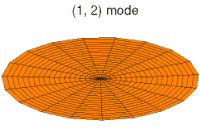Vibrations of a circular membrane

Imagine you have a really big drum that's perfectly round like a pizza. When someone hits the drum with a stick, it starts vibrating all over the place. The way the drum vibrates depends on lots of things, like how big it is, how hard it was hit, and what it's made of.
Now, let's say that we're not interested in the drum itself so much as the part right in the middle - that's the circular membrane. It's like a giant rubber band stretched out over the top of the drum, and when that rubber band vibrates, it creates sound waves that we can hear.
So, what makes the circular membrane vibrate? When you hit the drum, the stick pushes the membrane down in one spot, kind of like when you jump on a trampoline. That pushes the air molecules underneath it together, creating a high-pressure wave that travels outward in all directions. When that wave reaches the edge of the drum, it reflects back and creates another high-pressure wave that travels back to the center of the drum.
If the drum was just a flat surface, those waves would cancel each other out and you wouldn't hear anything. But because the drum is a circular membrane, the waves interfere with each other in a way that creates a pattern of vibrations. Those vibrations cause air molecules to compress and expand, and that makes the sound that we hear.
Different kinds of circular membranes can vibrate in different ways depending on their shape and the way they're hit. Sometimes the membrane vibrates in a way that makes a deep, low sound, and other times it vibrates in a way that makes a high-pitched sound. But no matter how it vibrates, we can always hear the circular membrane because it creates sound waves that travel through the air to our ears!
Now, let's say that we're not interested in the drum itself so much as the part right in the middle - that's the circular membrane. It's like a giant rubber band stretched out over the top of the drum, and when that rubber band vibrates, it creates sound waves that we can hear.
So, what makes the circular membrane vibrate? When you hit the drum, the stick pushes the membrane down in one spot, kind of like when you jump on a trampoline. That pushes the air molecules underneath it together, creating a high-pressure wave that travels outward in all directions. When that wave reaches the edge of the drum, it reflects back and creates another high-pressure wave that travels back to the center of the drum.
If the drum was just a flat surface, those waves would cancel each other out and you wouldn't hear anything. But because the drum is a circular membrane, the waves interfere with each other in a way that creates a pattern of vibrations. Those vibrations cause air molecules to compress and expand, and that makes the sound that we hear.
Different kinds of circular membranes can vibrate in different ways depending on their shape and the way they're hit. Sometimes the membrane vibrates in a way that makes a deep, low sound, and other times it vibrates in a way that makes a high-pitched sound. But no matter how it vibrates, we can always hear the circular membrane because it creates sound waves that travel through the air to our ears!
Related topics others have asked about:
